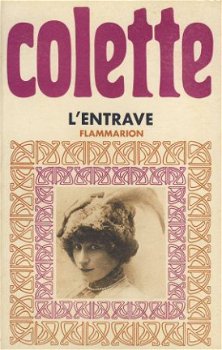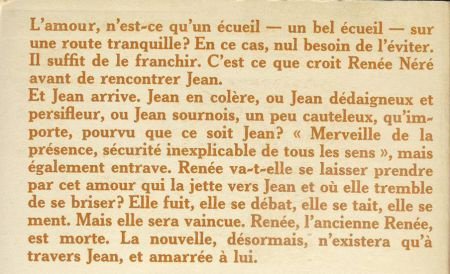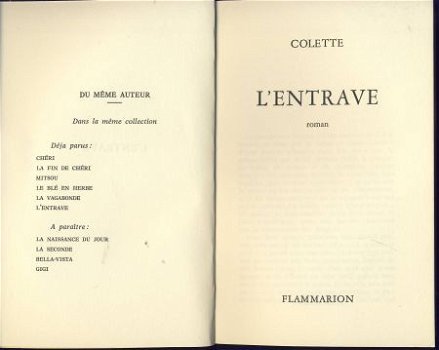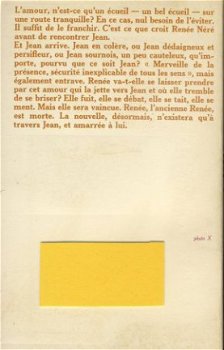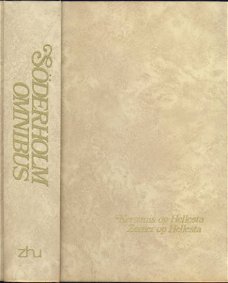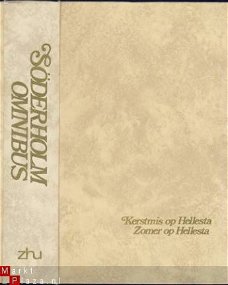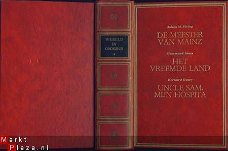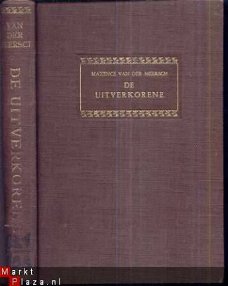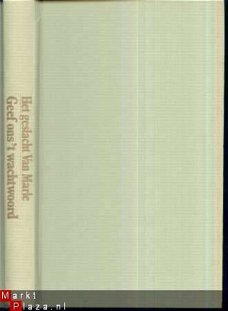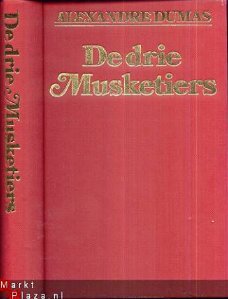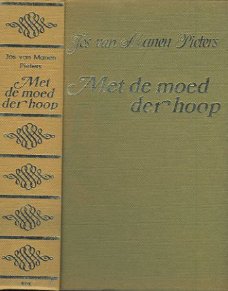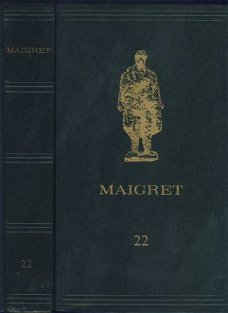
COLETTE **L' ENTRAVE** COLETTE **L'ENTRAVE **PAPERBACK**
Kenmerken
- Conditie
- Gebruikt
- Levering
- Niet van toepassing
Omschrijving
COLETTE
**L' ENTRAVE**
*****1970*****
FLAMMARION* *PAPERBACK*
FRAIS+INTACT+IMPECCABLE.!!
ARTICLE INVENTAIRE CODE 38.762
FORMAT 183 X 118 X 17 + 236PGS + 222 GRS
EXPEDITION EN BELGIQUE 2,61 EURO
**THE MERIT OF ORIGINALITY IS NOT NOVELTY; IT IS SINCERITY.THE BELIEVING MAN IS THE ORIGINAL MAN.; WHATSOEVER HE BELIEVES, HE BELIEVES IT FOR HIMSELF, NOT FOR ANOTHER.** dixit THOMAS CARLYLE (1795 - 1881)
Colette (1873-1954) - in full Sidonie-Gabrielle Colette
French novelist, belonging, in time, to the generation of
such authors as Marcel Proust, Paul Valéry, André Gide,
and Paul Claudel. Colette's career spanned from her early
20s to her mid-70s. Her main themes were joys and pains of
love, and female sexuality in the male-dominated world. All
her works are more or less autobiographical but Colette
intentionally blurred the boundaries between fiction and
fact. She wrote over 50 novels and scores of short stories.
Sidonie-Cabrielle Colette was born in the Burgundian village
of Saint-Sauveur-en Puisaye. She was the daughter of a
retired army captain, Jules-Joseph Colette. He had lost a
leg in the Italian campaign and worked as a taxcollector
with local political aspirations. Colette's mother, Adele
Eugenie Sidonie Landoy, known as 'Sidonie' or 'Sido', was an
unconventional character, a down-to-earth personality,
devoted to her pets, books, and garden. Colette spent a
happy childhood in rural surrounding, the scene of her many
novels. At the age of 20 Colette married the writer and
music critic Henri Gauthier-Villars, ('Monsieur Willy'); he
was 15 years her senior. Colette's biographers' have
labelled her first husband as a literary charlatan and
degenerate.
Encouraged to start a career as a writer Colette published
in short period four CLAUDINE novels (1900-03) under her
husband's pen name Willy. According to a famous story, he
locked Colette in her room until she had written enough
pages. The series of four novels depicted improper
adventures of a teenage girl. The series was a huge success
and inspired all kinds of side products - a musical stage
play, Claudine uniform, Claudine soap, cigars, and perfume.
However, Colette's own cosmetics shop went bankrupt. Tired
of her husbands unfaithfulness, Colette broke free of him in
1905. After divorce in 1906 Colette became a music-hall
performer at such places as La Chatte Amoureuse and L'Oiseau
de Nuit. On stage she bared one breast. A talk of the town,
Colette once mimed copulation in a sketch, which a riot at
the Moulin Rouge. Colette's protector and manager, a woman
known as 'Missy', was the niece of Napoleon III, the
Marquise de Belboeuf. Missy committed suicide in 1944 -
ruined and desperate. Among Colette's other friends and
probably lovers were Natalie Clifford Barney, an American
lesbian woman, and the Italian writer Gabriele d'Annunzzio.
In 1912 Colette married Henri de Jouvenel des Ursins, the
editor of the newspaper Le Matin, for which she wrote
theatre chronicles and short stories. Their daughter,
Colette de Jouvenel, later told that she was neglected by
her parents - her mother never wanted a child. Colette's
relationship with her young stepson, Bertrand de Jouvenel,
was a source of gossips. In the novel CHÉRI (1920) she
returned to the affair but depicted it from a point of view
of a sexually unexperienced young man.
In 1910 Colette published LA VAGABONDE, a story about an
actress who rejects a man she loves in order to live in an
independent way. During World War I Colette converted her
husband's St. Malo estate into a hospital for the wounded.
After the war she was made a Chevalier of the Legion of
Honour (1920).
The 1920s brought Colette enormous fame. She entered the
world of modern poetry and paintings, which centered around
Jean Cocteau, later her neighbor in Palais Royale. By 1927
Colette was frequently acclaimed as France's greatest woman
writer. Especially Colette's insights into the behavior of
women in love gained a sympathetic response from the reading
public.
Two central themes can be identified in Colette's mature
works: the nature and the mother-daughter bond. LA MAISON DE
CLAUDINE (1922) mythologized her childhood, LA NAISSANCE DU
JOUR (1928) and SIDO (1929) celebrated Colette's carefree
rural childhood, and the strength of her mother, whom the
author rarely saw but wrote her many letters. The letters
were destroyed by her brother after Sidonie died. In novels
such as LA VAGABONDE (1911), LE BLÉ EN HERBE (1923), LA
SECONDE (1929) and LA CHATTE Colette explored the struggle
between independent identity and passionate love. Most of
Colette's heroes and heroines, cocottes, bisexuals and
gigolos, came from the margins of society. Chéri, which is
one of her most famous book, tells the story of the end of a
six year affair between an aging retired courtesan, Léa,
and a pampered young man, Chéri. Turning conventions
upside-down it is Chéri who wears silk pyjamas and Léa's
pearls, he is the object of gaze. And in the end Léa
demonstrates all the survival skills which Colette
associated with femininity. The story continued in The Last
of Chéri (1951), which contrasts Léa's strength and
Chéri's fragility, leading to his suicide.
In the 1940s Colette portrayed her later years in L'ÉTOILE
VESPER (1946) and LE FANAL BLEU (1949),which constantly
questioned the relationship between autobiography and
fiction. GIGI (1945) was published when the author was 72;
the novel was made into a film in 1948. Vincente Minnelli
directed a musicalized version of the story in 1958.
In the 1930s Colette was made a member of the Belgian Royal
Academy. She was the first woman to be admitted to the
prestigious Goncourt Academy. In 1953 she became a grand
officer of the Legion of Honour. She won also many awards
for her work. During the last 20 years of her life Colette
suffered from a crippling form of arthritis, which had been
set off by the fracture of a fibula in 1931. Her marriage
with Henry de Jouvenal ended in 1924. From 1935 she was
married to Maurice Goudaket, whose pearl business had been
ruined during the Depression. Colette supported him because
as a Jew he did not find work and had to hide when the
Germans occupied France. Colette died on August 3, 1954 in
Paris, where her fame was no less legandary than that of the
writer Gertrude Stein(1874-1946) or the singer Edith Piaf
(1915-1963). Colette was accorded a state funeral despite
the refusal of Catholic rites on the grounds that she had
been divorced. Her funeral was attended by thousands of
mourners.
Selected works:
CLAUDINE À L'ÉCOLE, 1900 - Claudine at School (trans. by
J. Flanner / H. Mirande)
CLAUDINE À PARIS, 1901- Claudine in Paris
CLAUDINE EN MÉNAGE, 1902 - Claudine Married
CLAUDINE S'EN VA, 1903 - The Innocent Wife (trans. by F.
Blossom)
SEPT DIALOGUES DE BÊTES, 1904 - Creatures Great and Small
(trans. by Enid McLeod)
MINNE, 1904
LES ÉGAREMENTS DE MINNE, 1905
LA RETRAITE SENTIMENTALE, 1907 - The Retreat from Love
(trans. by M. Crosland)
LES VRILLES DE VIGNE, 1908 - The Tendrils of the Vine
L'INGÉNUE LIBERTINE, 1909 - The Gentle Libertine (trans. by
R.C. Benet)
LA VAGABONDE, 1910 - The Vagabond (trans. by J. Flanner /
Enid McLeod)
L'ENTRAVE, 1913 - The Shackle
L'ENVERS DU MUSIC-HALL, 1913 - Music-Hall Sidelights - film
1935, dir. by Max Ophuls
LA PAIX CHEZ LES BÊTES, 1916 - Cats, Dogs, and I
LES HEURES LONGUES, 1917
LES ENFANTS DANS LES RUINES, 1917
DANS LA FOULE, 1918
MITSOU, 1919 - (trans. by J. Terry)
CHÉRI, 1920 - (trans. by Roger Senhouse) - suom.
CELLE QUI EN REVINET, 1921
LE VOYAGE ÉGOÏSTE, 1922
LA MAISON DE CLAUDINE, 1922 - My Mother's House (trans. by
E. McLeod and U.V. Troubridge) - Claudinen koti
RÊVERIE DU NOUVEL AN, 1923
LE BLÉ EN HERBE,1923 - The Ripening Seed - Vilja oraalla -
film 1956, dir. by Claude Autant-Lara
AVENTURES QUOTIDIENNES, 1924
LA FEMME CACHÉE, 1924
LE ENFANT ET LES SORTILÈGES, 1925 - The Boy and the Magic
(trans. by C. Fry)
LA FIN DE CHÉRI,1926 - The Last of Chérie (trans. by E.
McLeod / Roger Senhouse) - Cherin loppu
LA NAISSANCE DU JOUR, 1928 - A Lesson in Love 8(trans. by
R.C. Benet)
LA SECONDE, 1929 - The Other One (trans. by R. Senhouse and
E. Tait)
DOUZE DIALOGUES DE BÊTES, 1930 - Creatures Great and Small
SIDO, 1930 - (trans. by E. McLeod)
RENÉE LA VAGABONDE, 1931
CES PLAISIRS (first ed.) / LE PUR ET L'IMPUR, 1932 - The
Pure and the Impure
LA CHATTE,1933 - The Cat
DUO, 1934 - (trans.)
SPLENDEUR DES PAPILLONS, 1936
MES APPRENTISSAGES, 1936 - My Apprenticeships (trans. by H.
Beauclerk)
BELLA-VISTA, 1937
LE TOUTOUNIER, 1939
CHAMBRE D'HÔTEL, 1941 - Chance Acquaintances (trans. by
P.L. Fermor)
LE PUR ET L'IMPUR, 1941 - The Pure and the Impure (trans. by
E. Dally)
JOURNAL À REBOURS, 1941 - Looking Backwards (trans. by D.
Le Vay)
MES CAHIERS, 1941
JULIE DE CARNEILHAN, 1941 - (trans. by P.L. Fermor)
DE MA FENÊTRE, 1942
LE KÉPI, 1943
PARIS DE MA FENÊTRE, 1944
GIGI, 1944 - (trans. by R. Senhouse) - film versions: 1948
dir. by Jacqueline Audry, starring Daniele Delorme, Gaby
Morlay, Yvonne de Bray; musical version in 1958 dir. by
Vincente Minnelli, starring Leslia Caron, Louis Jourdan,
Maurice Chevalier - note: Leslie Caron's vocals were dubbed
by Betty Wand
LA TENDRON, 1944
LA DAME DU PHOTOGRAPHE, 1944
CHATS, 1945
L'ÉTOILE VESPER, 1946 - The Evening Star (trans. by D. Le
Vay)
BELLES SAISONS, 1947
POUR UN HERBIER, 1948 - For a Flower Album (trans. by R.
Senhouse)
TRAIT POUR TRAIT, 1949
JOURNAL INTERMITTENT, 1949
LA FLEUR L'ÂGE, 1949
LE FANAL BLEU, 1949 - The Blue Lantern (trans. by R.
Senhouse)
EN PAYS CONNU, 1950
CHÉRI, 1952 (play)
Six Novels, 1957
The Collected Stories of Colette, 1983 (ed. by Robert G.
Phelps)
Collected Stories, 1983 (ed. by R. Phelps)
Flowers and Fruit, 1986 (edited by Robert Phelps)
